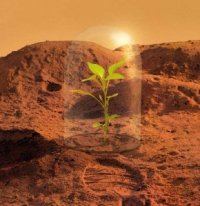On the moon soil, most of the plants hardly grew at all after germinating, or they died. To Wamelink’s surprise the Martian soil delivered much better results. He studied the germination and growth of 14 species of plant on artificial Martian and moon soils. These soils from Hawaii and Arizona are supplied by NASA, their composition is very close to that of the surface of Mars and the moon. Wamelink planted pots of moon and Martian soil with seeds of leguminous plants (clover and lupin), agricultural crops (tomato, rye and cress) and wild plants (arnica and field mustard). Control trials were done with river sand from deep parts of the Rhine. The ecologist monitored what happened closely over 50 days. The Martian soil proved the most fertile – even more fertile than the Rhine sand. All the seeds germinated in the Martian soil, but rye, carrots, red fescue and cress did best. The biomass yield (growth) was better on the Martian soil than on the Rhine sand, too. Wamelink: ‘This is probably because the Martian soil retains moisture better. And it seems that there are enough minerals in the soil. The Martian soil we used is pretty much like the Loess soils we know from Limburg.’
The Martian soil we used is pretty much like the Loess soils we know from Limburg
Wieger Wamelink
On the basis of Wamlink’s trials, gardening on the moon seems less promising. The plants germinated but then failed to grow much. The best-case scenario was that they did not die. But many plants did not survive the experiment. Wamelink blames this on the alkaline moon soils (pH 9). ‘What is more, there is a lot of aluminium in moon soil, and that is basically toxic for plants.’

Wamelink would like to continue with his experiments. ‘I would love to take this further. It is nice and extremely innovative research. I have approached NASA and they are keen to be involved.’ A VIDI grant application is in the pipeline. In follow-up research, Wamelink would like to try out various nutrient solutions and light conditions. The light on other planets differs from the light on earth in spectrum, daylight hours and intensity.
Vegetable plots on other planets are not as much something out of science fiction as they would seem. NASA has plans for conducting germination and growth tests on the moon. This experiment may take place next year when the unmanned Moon Express goes to the moon.
